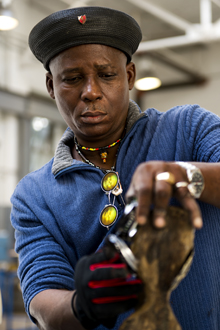Creole artists meld spiritual roots with individual style
“My sculpture is god,” said Haitian artist Andre Eugene. He, along with New Orleans artist Charles Gilliam, participated in a discussion, “Exhibiting the Vernacular: Salvaged Art & Urban Space,” on Friday (Nov. 9) in the Stone Auditorium of Woldenberg Art Center on the Tulane uptown campus.

Haitian artist Andre Eugene constructs a sculpture of carved mahogany, marble and auto parts. The working title of the piece is Looking for Light. (Photo by Paula Burch-Celentano)
Eugene"s creations range from sculptures of gods and goddesses constructed of car chassis and motor gears to silhouette cutouts of spirits both friendly and evil made of old tires.
Nick Spitzer, Tulane professor of anthropology and American studies and founder and host of the public radio program “American Routes,” facilitated the discussion.
Spitzer said, “These artists from the Creole cultures of Haiti and New Orleans are responding to their environment with humor and connectivity. While rooted in deeply spiritual traditions, they are highly individualized.”
Gilliam grew up in the Lower Ninth Ward of New Orleans, near the Mississippi River, where he still lives and collects driftwood and creates sculpture of old bicycles and other found materials. “I can turn anything into art,” said Gilliam, whose busts of musicians are displayed in House of Blues clubs.
Among Gilliam"s works is Ain"t That a Shame, a depiction of the legendary musician Fats Domino standing on the roof of his house with a baby grand piano during the Katrina flood. Gilliam painted the humorous artwork on a piece of a wooden dresser rescued from the deluge.
Eugene is a member of the Haitian Atis Rezistans Arts Collective and founder of E. Pluribus UNUM Musee d"Art in Port-au-Prince, Haiti, and Gilliam is owner and creator of the Algiers Folk Art Museum and Blues Museum in New Orleans.
The Friday event, sponsored by the Stone Center for Latin American Studies and the Latin American Graduate Organization, was followed by a workshop on Saturday in which artists of all levels were invited to create pieces while observing Eugene build sculpture of mahogany, marble and auto parts.
